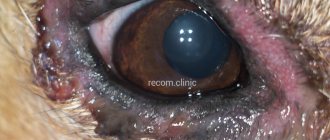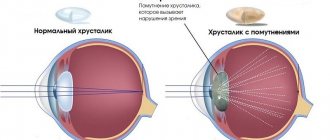Conjunctivitis is a disease that affects not only humans, but also dogs. If left untreated, it can lead to partial or complete blindness, so immediate action should be taken. If you notice alarming symptoms in your dog, immediately take him to the veterinarian, who will examine the eye, prescribe additional tests and apply effective treatment. What are the symptoms and how to treat conjunctivitis in your dog. Learn about dog breeds that are prone to eye diseases.
Signs of conjunctivitis in dogs
Symptoms of conjunctivitis in dogs are not always the same. They can be more or less severe, depending on the type of pathogen and the resistance of the four-legged organism. Inflammation can develop in both eyes or just one.
The first signs of conjunctivitis in a dog can often be missed. In this case, the eye can become seriously inflamed, making the layer under the eye wet or sticky. In addition, inflammatory exudate can accumulate, forming so-called “Shins”, which arise as a result of self-cleansing of the conjunctiva. Over time, more and more such “dream books” may appear; they are also accompanied by the presence of serous or purulent discharge.
The most common symptoms of conjunctivitis in dogs
- conjunctival hyperemia;
- serous, mucous or mucopurulent discharge from the eye;
- excessively watery eyes;
- conjunctival edema;
- collapse of the eyeball;
- protrusion of the third eyelid;
- spastic spasm of the eyelids;
- squatting of the eye or affected eye;
- the presence of papules on the posterior surface of the third eyelid;
- Rubbing the eyes with a paw or rubbing with other objects.
Conjunctivitis can be divided into acute and chronic , with the acute course characterized by the fact that severe symptoms appear in a short time. In addition to changes in the functioning of the eye itself, systemic symptoms such as dog fever, lethargy, and weakness .
Treatment
How to treat conjunctivitis in dogs at home? We will talk about this later, but first of all, remember the main rule: you should not prescribe treatment yourself! You may make a mistake in making a diagnosis and start treating your dog for something else, thereby harming it even more.
Treatment of a dog with conjunctivitis should begin with confirming the diagnosis and identifying the causes that led to the inflammatory process. Without this, it is impossible to prescribe truly effective treatment. The simplest steps to treat at home:
- This is wiping the inner corners of the eyes with clean gauze (rolled or folded in several layers) soaked in boiled warm water, a decoction of herbs (chamomile, for example). Some people decide to wipe their eyes with strong black, non-fruit tea (no sugar!).
- Be sure to take care of your pet. Keep outdoor walks to a minimum so that wind, dust and sun rays do not disturb the mustache. At home, improve the living conditions: find a warm corner for your pet, where there is no draft and it is clean.
What's the first thing owners do? They run to the pharmacy for tetracycline eye ointment and hope that this will relieve their four-legged friend from conjunctivitis. However, in most cases, this ointment only dulls the symptoms. It is often necessary to use stronger antibiotics, and they will have to be administered intramuscularly for at least 5 days! Antiviral drugs and immunostimulants may also be required (especially if the cause of inflammation lies in a viral disease).
Don’t forget about local therapy – drops and ointments. Kanamycin, chloramphenicol (be careful with babies and pregnant women), sodium sulfate and the famous drops - Diamond Eyes. But remember that everything is prescribed only after an in-person examination of the pet by a veterinarian! Only a doctor can say what exactly, in what dosage and for how long should be used.
To prevent the dog from injuring itself while trying to scratch its inflamed eye, put a special protective collar on the mustache’s neck.
Recommendations on how to properly put drops into your dog’s eyes:
Canine conjunctivitis and other eye diseases
Dry eye syndrome
Dry eye syndrome, or sicca keratitis and scleritis, is a serious, painful eye disease that, if left untreated, can lead not only to conjunctivitis, but also to deterioration or even loss of vision. Possible causes of dry eye syndrome are:
- insufficient tear production;
- insufficient secretion of tears;
- hypoplasia of the lacrimal glands or its absence.
Follicular inflammation of the third eyelid
Most often this concerns young dogs under 1.5 years old. This is a seemingly harmless viral disease, which, however, often becomes infected with a bacterial infection - this is facilitated by the local weakening of the protective mechanisms of the eye area by viruses. On the inside of the third eyelid there are absorbent lumps, which become larger as a result of infection, and this causes irritation of the conjunctiva. It is associated with soreness and inflammation of the eyelids and sclera.
Irregular canine eyelid shape
- entropy - collapse of the edge of the eyelid towards the eyeball;
- ectropium - the edge of the eyelid that extends outward.
Irregular eyelid shape can damage the eyes in both cases. With entropy, the conjunctiva and cornea are mechanically irritated, which can be a direct cause of inflammation. In the case of ectropia, there are disturbances associated with the distribution of the tear film, therefore, the conjunctiva is not sufficiently moisturized and may be susceptible to damage.
Conjunctivitis can also be caused by abnormal eyelash structure. Dogs often have what are called double-row eyelashes, which is an extra row of eyelashes. Such eyelashes can also mechanically damage the conjunctiva, leading to inflammation.
Congenital visual defects are noticeable immediately when the dog opens his eyes or appear later during the puppy's growth.
Caring for your dog during treatment and disease prevention
Correct and timely therapy, in most cases, works quite effectively. But there are a number of measures that help reduce the risk of infection. If you adhere to the norms and rules, you can always avoid uncomfortable treatment.
- Examination of your pet's eyes.
- Preventative examinations at the veterinarian.
- Proper nutrition. Inclusion in the diet of foods that have a beneficial effect on vision: carrots, pumpkin, spinach, egg yolks.
- For allergy sufferers, the first cure is eliminating the root cause of the reaction.
- Protect your pet from drafts. Especially after water procedures.
- Try to protect your pet from communicating with homeless infected relatives.
If treatment cannot be avoided, during the procedures it is recommended:
- Reduce walking time.
- Avoid contact of the pupil with: dust, smoke, pollen, etc.
- Don't overcool your puppy.
- Proper, doctor-recommended nutrition.
- Follow all veterinarian instructions exactly.
Causes of conjunctivitis in dogs
Bacterial conjunctivitis
It is rarely the main cause of inflammation. Bacteria multiply more intensively when the conjunctiva has already been damaged by other factors, such as viruses, or when its continuity is disrupted due to trauma. The bacteria responsible for this type of inflammation are mainly staphylococci, streptococci , Pasteurella sp., Chlamydophila psittaci and Haemophilus influenzae.
A four-legged dog can get sick at any age. Puppies are susceptible, for example, to neonatal conjunctivitis, which occurs when the puppy's eyes are still closed. Exudate is formed by closed eyelids.
Viral conjunctivitis
This could be, for example, herpesvirus type 1, canine distemper virus, that is, CDV virus, canine adenovirus type 2 or others that tend to multiply in the conjunctiva of quadrupeds.
Conjunctivitis due to parasite infestation
Some exotic parasites can attack the eye, including the conjunctiva. Of course, such cases are rare in our country, since these parasites are not common in our country, but this does not mean that they are not registered at all.
Allergic conjunctivitis
The conjuncture has direct contact with others. It also comes into contact with many antigens that are attracted to the dog's immune system. Then the immune response is directed against them. This is a very good defense system that allows you to immediately react and eliminate, for example, pathogenic viruses or bacteria from the body. Unfortunately, sometimes the immune system goes overboard and misuses the immune response against harmless antigens—for example, allergens from goose feathers in your pillow, or from grass or pollen. The increased sensitivity of a dog's immune system to such antigens is called an allergy . Symptoms appear when the dog comes into contact with allergens to which it is allergic.
Conjunctivitis associated with the presence of a foreign body
These are foreign bodies that have entered the conjunctiva, and four-legged animals are not able to get rid of them on their own (for example, dust or a fragment of an object), or those that chronically irritate the mucous membrane - these are, among others, the eyelashes of pets that grow abnormally or the eyelid collapses, mechanically irritates the conjunctiva.
This inflammation is caused by mechanical damage to the conjunctiva. This is very dangerous if the foreign body is not removed quickly - it can damage the sclera or cornea and even lead to blindness .
Chemical conjunctivitis
The eye can be irritated through contact of the conjunctiva with smoke, vapors or various chemicals, including creams or ointments, which should not come into contact with the mucous membrane of the tetrapod eye. This can lead to inflammation - which is why it is so important to know how to bathe a dog or what products to use to care for the eye area.
What should a dog owner do?
If something gets into the eye, there is lacrimation, if the dog whines, rubs the eye with its paw and shows in every possible way that it hurts, then it is damaged. First of all, you need to examine the eye and, if possible, determine the cause of the pain.
In order to examine the eyeball, you first need bright light. Pull your eyelids up and down with your finger. Due to the elasticity and mobility of the skin on the muzzle, the lower eyelid easily droops, exposing the conjunctival sac and much of the cornea behind it. To examine the eye under the upper eyelid, you need to evert it out (or dislocate it).
Mild, irritating forms of conjunctivitis can be treated at home. The eye is cleaned with a solution of 2% boric acid, specially used in ophthalmology. Clear improvement should occur within 24 hours. Otherwise, consult a doctor. The cause of the disease may be a foreign body or other serious damage to the eye.
If you doubt the diagnosis or treatment is carried out at home without obvious signs of improvement within 24 hours, you should call a veterinarian. Please note that prolonged administration of antibiotics into the eye can lead to fungal diseases!
How to treat conjunctivitis?
The treatment method depends on the type of factor that causes conjunctivitis in quadrupeds. Therefore, before administering therapy, the veterinarian must first determine what is causing the disease. However, you should be aware that this is not always possible. This inflammation is usually caused by many factors at once, such as viruses and bacteria.
For a bacterial infection, topical antibiotic therapy (eye drops and antibiotic ointments) or systemic (oral or injectable antibiotic) is needed. If the inflammation is a consequence of injury or the presence of a foreign body, the veterinarian removes them and applies methods to save individual elements of the eyeball. For allergic conjunctivitis, the best treatment is to avoid exposure to the sensitizing allergen. In situations where the inflammation is caused by abnormal eyelid structure, you may need to undergo surgery to correct the defect.
How to clean your dog's eyes?
The dog's eyes should only be washed with products intended for this purpose. You can get such products from veterinary clinics and good pet stores. The veterinarian may also recommend washing the eyes with saline solution, chamomile infusion, or simply boiled water.
Use disposable sterile gauze to wash your eyes. Never swab both eyes because you can transfer infectious agents from one eye to the other—one swab can only be used within one eye.
Moisten a gauze pad and rinse the eye from the inside to the outer corner of the eye.
When should you clean your dog's eyes?
Dogs suffering from allergic conjunctivitis or frequent eye infections should receive this treatment daily or several times a week. This allows you to collect allergens that may cause allergy symptoms.
Cleaning your dog's eyes should be done every time you return, for example from the beach, where sand can get into the four-legged conjunctiva, and after every pet bath. This will remove any shampoo that you were unable to wash off during your bath and that may have gotten into your eyes.
How to take care of your eyes?
Observe your dog's eyes daily. Check whether the conjunctiva is not red, or there is a so-called “Stamp”, or there was no discharge. What is even more disturbing is the quadrupeds' frequent squatting of one or both eyes and rubbing various objects around the eye. React immediately if you notice something alarming - take your pet to the vet.
The dog is rubbing its eyes - what to do?
The best thing you can do is take your dog to the vet for an appointment to help determine the cause of the itching. Your pet may experience discomfort and even pain associated with conjunctivitis, but there is more to it. Symptoms may also result from invading parasites that feed on the surface layers of the skin.
Based on the history, clinical examination and additional tests, the veterinarian will make a diagnosis that will allow effective treatment. It is possible that your dog will have to wear a collar during therapy to prevent him from scratching. It is important not to remove the collar at night.
What types of conjunctivitis are there?
The disease occurs in acute or milder forms. There are the following types of conjunctivitis in puppies:
- Catarrhal. One of the lightweight forms. Characterized by: copious release of fluid similar to tears, redness of the mucous membrane, swelling of the eyelids. Most often appears with: injuries, infections.
- Allergic. It appears in pets prone to allergies to various sources. Manifestation: tearing, redness of the eye, eyelid.
- Purulent inflammation. Signs: yellow (gray, green) discharge, disgusting odor in the irritated area, swelling, photophobia. Also sticking of the eyes, the formation of a crust on this surface. Sometimes a student simply cannot open his eyes. The dog's temperature rises, severe irritation is observed, and he scratches the affected areas with his paw to no avail. It is accompanied by a psychological disorder of the pet, anxiety, inertia towards games and food. This reaction is caused by the entry of purulent viruses into the body. The disease is acute, develops rapidly, and often affects both eyes. This species requires serious medical treatment in the early stages of development.
- Follicular variety. Inflammatory processes affect not only the conjunctiva, but also affect the lymphatic follicles of the eyelids. Symptoms: red follicles on the inner surfaces of the eyelids and their curling, no ability to blink. Also: discharge of fluid (may be purulent), redness, fear of light, constant feeling of awkwardness, discomfort for the puppy. Appears when dust, smoke, wool, etc. gets on the mucous membrane of the eye. Young representatives of four-legged animals especially suffer from this form.
Additional Information
. The disease can also be infectious, which is contagious to other animals, or caused by external factors, which is not transmitted. For humans, this infection in any form is not dangerous.
Dog breeds that get sick most often
The most vulnerable to inflammation are those quadrupeds that have a flattened snout, causing their eyes to be slightly shallower. Because of this, the eyeball of such dogs is more convex, and the eyelids are not able to effectively protect it from external factors.
Dogs with hair and long fur also get sick more often because their outer coat can mechanically irritate the conjunctiva.
- French Bulldog;
- English bulldog;
- boxer;
- Shih Tzu;
- Cocker Spaniel;
- Pekingese;
- poodle;
- Yorkshire Terrier.
Dogs living in a group get sick more often. This is because infectious agents, which are the most common cause of eyelid and eyeball mucous membranes, spread more easily between dogs that have direct contact with each other - such as dogs in a shelter or those that are often found in animal hotels.
What kind of disease is this?
Canine conjunctivitis is a disease associated with inflammation of the mucous membrane, the inner surface of the eyelid, and the eyeball. Such a disease may be associated with chronic manifestations of various diseases or weakened immunity in a four-legged animal. It manifests itself in two phases - acute and chronic. This disease requires proper, adequate veterinary treatment. If you treat the problem negligently, your pet may lose its sight forever. Therefore, timely assistance and the right approaches to the problem are always advisable!
Surgical treatment: when to contact a veterinarian
Surgical intervention is required in cases of prolonged follicular conjunctivitis. When the eyelid swells and becomes covered with small blisters, you need to act urgently to relieve your pet of pain and discomfort. In difficult cases, doctors have to remove follicles in the third eyelid manually.
The worst outcome is removal of the eye, in case of ulceration of the mucous membrane and apple. They resort to surgery only when conservative treatment does not help.
Disease prevention
Breeds that are prone to it especially need the prevention of conjunctivitis.
All dogs with long hair and large eyes suffer from chronic excessive lacrimation, and therefore require careful care and attention from the owner.
Prevention will eliminate the risk of problems and stop the development of infectious or colds. The owner must follow several rules:
- Regular vaccination against dangerous viruses;
- Comfortable living conditions for the pet (no drafts or smoke, high-quality food, winter heating of the kennel, walking in protective clothing);
- No contact with unfamiliar street dogs or sick pets;
- Walking in areas without bushes, thorns, avoiding landfills and waste accumulation;
- Complete cure for any disease.










